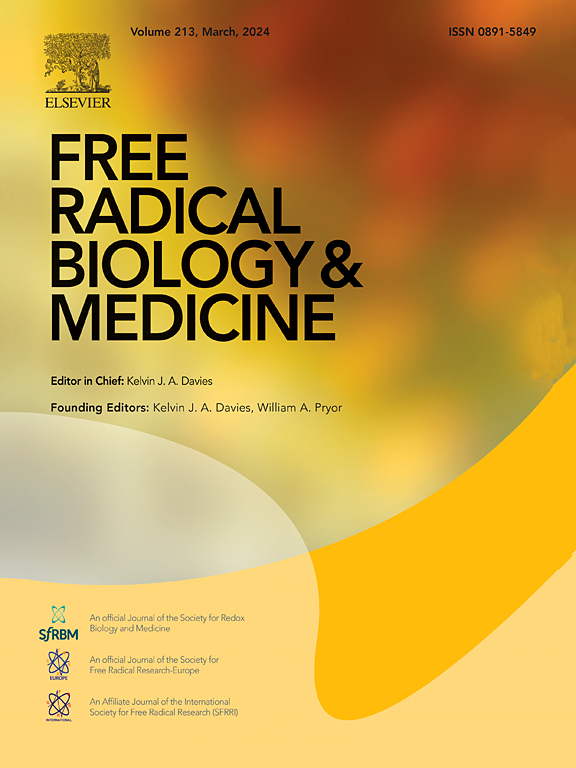Selective nitric oxide redistribution by phospholipid nanoparticles: A novel strategy to mitigate massive nitric oxide release and prevent reperfusion injury in septic shock
IF 7.1
2区 生物学
Q1 BIOCHEMISTRY & MOLECULAR BIOLOGY
引用次数: 0
Abstract
Nitric oxide plays a critical role in regulating vascular tone, but excessive nitric oxide release during septic shock results in hypotension due to excessive vasodilation and the formation of toxic free radicals. VBI-S is a phospholipid nanoparticle based fluid composed of lipid bilayers formed primarily by phosphatidylcholine and micelles of soybean oil encapsulated by a monolayer of phosphatidylcholine. These nanoparticles offer a novel solution by absorbing and redistributing nitric oxide and nitrite, potentially mitigating the harmful effects of excessive nitric oxide in sepsis. This paper proposes a mechanism in which VBI-S not only redistributes nitric oxide but also reduces ischemia-reperfusion injury by limiting the production and availability of reactive species. VBI-S captures nitric oxide and nitrite in areas of high concentration and redistributes them in low-nitric oxide environments, primarily within oxygen-deprived tissues. Nitrite then contributes to nitric oxide regeneration in hypoxic microvasculature via various reduction pathways, thereby improving tissue perfusion and minimizing oxidative stress. Preliminary studies suggest that nitrite may also decrease reactive species production, primarily superoxide, through the inhibition of mitochondrial complex I. Additionally, the lipid composition of VBI-S is rich in poly and monounsaturated fatty acids which allows VBI-S to act as a substrate for peroxidation via peroxynitrite. Therefore, VBI-S acts as a decoy target thereby protecting cellular membranes from oxidative damage caused by reactive species. These findings position VBI-S as a promising therapeutic agent, offering both nitric oxide regulation and protection against hypotension and toxic free radicals in septic shock patients. Further research is necessary to fully elucidate the molecular pathways and optimize its clinical application.

通过磷脂纳米颗粒选择性重新分配一氧化氮:减轻感染性休克中大量一氧化氮释放和预防再灌注损伤的新策略。
一氧化氮在调节血管张力中起着至关重要的作用,但感染性休克时过量的一氧化氮释放会由于血管过度舒张和有毒自由基的形成而导致低血压。VBI-S是一种基于磷脂纳米颗粒的液体,由磷脂酰胆碱和豆油胶束组成的脂质双层组成,这些脂质双层主要由磷脂酰胆碱单层包裹。这些纳米颗粒通过吸收和重新分配一氧化氮和亚硝酸盐提供了一种新的解决方案,可能减轻过量一氧化氮对败血症的有害影响。本文提出了VBI-S不仅重新分配一氧化氮,而且通过限制反应物质的产生和可用性来减少缺血再灌注损伤的机制。VBI-S捕获高浓度区域的一氧化氮和亚硝酸盐,并将其重新分配到低一氧化氮环境中,主要是在缺氧组织内。然后,亚硝酸盐通过各种还原途径促进缺氧条件下的一氧化氮再生,从而改善组织灌注并减少氧化应激。初步研究表明,亚硝酸盐也可能通过抑制线粒体复合体i来减少活性物质的产生,主要是超氧化物。此外,VBI-S的脂质组成富含多不饱和脂肪酸和单不饱和脂肪酸,这使得VBI-S可以通过过氧亚硝酸盐作为过氧化的底物。因此,VBI-S作为诱骗靶标,从而保护细胞膜免受活性物质引起的氧化损伤。这些发现表明VBI-S是一种很有前景的治疗药物,在感染性休克患者中提供一氧化氮调节和抗低血压和有毒自由基的保护。为充分阐明其分子途径,优化其临床应用,还需进一步研究。
本文章由计算机程序翻译,如有差异,请以英文原文为准。
求助全文
约1分钟内获得全文
求助全文
来源期刊

Free Radical Biology and Medicine
医学-内分泌学与代谢
CiteScore
14.00
自引率
4.10%
发文量
850
审稿时长
22 days
期刊介绍:
Free Radical Biology and Medicine is a leading journal in the field of redox biology, which is the study of the role of reactive oxygen species (ROS) and other oxidizing agents in biological systems. The journal serves as a premier forum for publishing innovative and groundbreaking research that explores the redox biology of health and disease, covering a wide range of topics and disciplines. Free Radical Biology and Medicine also commissions Special Issues that highlight recent advances in both basic and clinical research, with a particular emphasis on the mechanisms underlying altered metabolism and redox signaling. These Special Issues aim to provide a focused platform for the latest research in the field, fostering collaboration and knowledge exchange among researchers and clinicians.
 求助内容:
求助内容: 应助结果提醒方式:
应助结果提醒方式:


